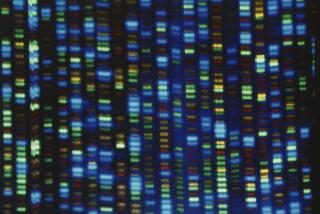Gale-Soviet Atom Victim Study OKd : Lifelong Watch on 100,000 Exposed to Fallout Planned
- Share via
MOSCOW — About 100,000 people with greater risks of developing cancer because of the Chernobyl accident will be medically monitored for life under an agreement signed Friday by American and Soviet physicians.
Dr. Robert P. Gale, a UCLA specialist in bone marrow transplants, announced that he had reached agreement with Soviet specialists on the study of long-term effects of radiation exposure.
Only a “rather small” percentage of the 100,000 people will actually develop cancer, Gale said at a news conference. He argued that some recent projections of tens of thousands or hundreds of thousands of additional cancers related to Chernobyl were “substantial overestimates.” He said that the data is far too limited to make an accurate forecast of how many additional cancers will occur because of the radioactivity spewed into the air by the damaged Chernobyl reactor.
5 Recipients Survive
Gale said that five of 13 Soviet patients who received bone marrow transplants have survived but that six victims of exposure to radiation who received fetal liver transplants have since died.
A leading Soviet specialist, Dr. Andrei Vorobyev, appeared with Gale at the news conference and said that bone marrow transplants are effective only in a fraction of cases where the radiation dose was very large and almost fatal.
The long-term monitoring agreement, signed by Gale and Vorobyov, does not involve the U.S. government.
A Soviet deputy minister of health Thursday put the death toll at 26, including 24 fatalities from radiation after the No. 4 reactor at Chernobyl exploded and burned last April 26. Gale said he expects two or three additional deaths from the most critical group of patients.
Another 187 people are still hospitalized with serious radiation sickness, Gale reported.
Flew Over Plant
Gale said that he visited Kiev, 60 miles south of the reactor site in the Ukrainian republic, and flew over the Chernobyl nuclear power plant in a helicopter to get a firsthand look at decontamination measures and medical treatment.
He said that he is favorably impressed by Soviet monitoring of water, milk and food in the Ukraine to make sure they are not contaminated.
Even so, he added, he had received Soviet data indicating that the average person in Kiev, a city of 2.5 million, would be exposed to 15 to 30 times more radiation than normal during the first year after the disaster. He noted that any increase in the amount of radiation increases the risk of cancer.
Gale said that lifetime monitoring is essential to guard the health of the 100,000 people judged to be most at risk following the Chernobyl explosion.
“One of the major objectives of our joint efforts is to carefully follow cancer incidences in the Ukraine and surrounding areas for an indefinite period,” he said.
“Particular focus is placed on the approximately 100,000 individuals felt to be at highest risk,” he added. “I believe careful analysis of these individuals is imperative.” A massive effort by hundreds of doctors, scientists and others to organize the record-keeping and medical checks for this group is under way, Gale added.
4 Days After Announcement
Gale, a professor at UCLA Medical School, arrived in Moscow on May 2, less than four days after the belated announcement of the nuclear accident, to help with bone marrow transplants.
Firefighters, who kept the radioactive blaze from reaching neighboring reactors, suffered the worst fatality rate. Doctors, plant workers and guards also were stricken with heavy doses of radiation on the night the reactor exploded.
The only persons not in the plant who suffered from radiation sickness, Vorobyev said, were a bicyclist and a man standing barefoot in an orchard.
Initially, Gale said he was told by Soviet authorities, about 1,000 to 2,000 persons were screened for radiation exposure. Between 400 and 500 were hospitalized in Moscow or Kiev, he added, and the most serious cases numbered fewer than 100.
Deserted City
The city of Pripyat, not far from the plant, is being decontaminated, but the work is not proceeding as rapidly as desired for reasons that are not clear, Gale said.
The city, which once had 40,000 inhabitants, is now deserted, and one sign of a hasty exodus is laundry still hanging from balconies, he said.
Asked about rumors in Moscow that pregnant women in Kiev were seeking abortions in the wake of the Chernobyl disaster, Gale said he was told that a commission had studied the question and decided to leave the decision on abortions up to each woman and her doctor.
More to Read
Sign up for Essential California
The most important California stories and recommendations in your inbox every morning.
You may occasionally receive promotional content from the Los Angeles Times.











